Disperis woodii
Disperis woodii Bolus
Family: Orchidaceae
Common names: horned kappie, Wood’s disperis (Eng.); horingmoederkappie (Afr.)
Introduction
Disperis woodii is a tiny terrestrial orchid, with a cluster of leaves at the base and just one stem that produces a single flower with a long pointed cap, from late summer.
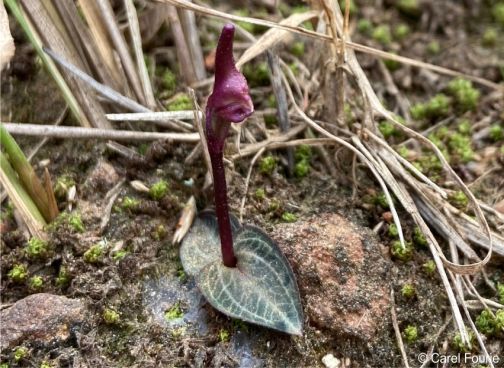
Description
Description
Disperis woodii is a terrestrial herbaceous plant with a tuberous rootstock, that grows from 50 to 150 mm tall. It has 2 leaves, leaf arrangement is variable and can be opposite, subopposite or alternate and leaves may be spaced up to 40–70 mm apart. Leaves are ovate, dark green with silvery white veins, 10–25 × 6–15 mm. Inflorescence single-flowered. Flower whitish or tinted with pink, median sepal darker or olive, sideways sepals marked with longitudinal pink streak. Ovary and pedicel 12–15 × 3–4 mm. Seeds tiny, circular and black. It flowers in late summer, autumn and winter, between March and August.
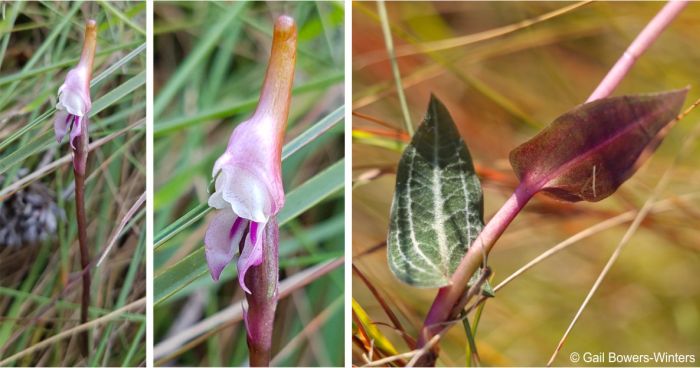
Conservation Status
Status
Disperis woodii was assessed as Vulnerable in 2018, previously assessed as Declining in 2009 and Least Concern in 2002. The primary reason for the disappearance of this species from the sites where it used to occur, surrounding East London in the Eastern Cape and along the KwaZulu-Natal coast, is urban expansion and development. Very few coastal grasslands remain intact along the KwaZulu-Natal coast due to the large-scale conversion of their habitat to sugarcane plantations. The last subpopulations inland from Durban and in the vicinity of Port Elizabeth are still in danger due to habitat loss brought on by urban growth.
Disperis woodii is listed under Cites Appendix 2.
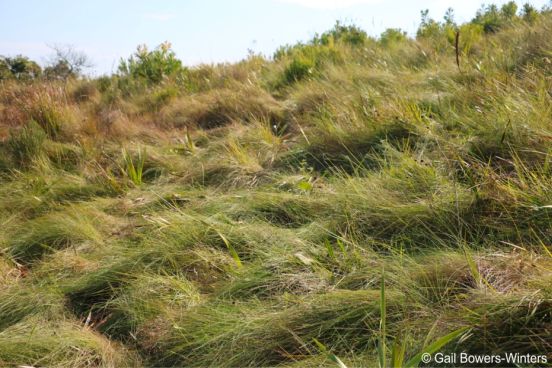
Distribution and habitat
Distribution description
In South Africa, Disperis woodii is widely distributed from Kosi Bay in KwaZulu-Natal to Port Elizabeth in Eastern Cape, from near sea level to about 1 800 m. It has also recently been identified on Réunion. It prefers sandy grassland, sometimes marshy ground, and is often found on south-facing cuttings of paths where it will grow in the shade of overhanging, low grassy vegetation. It is possible that this species is more widespread than current records indicate because it is small and inconspicuous and is thus difficult to notice.
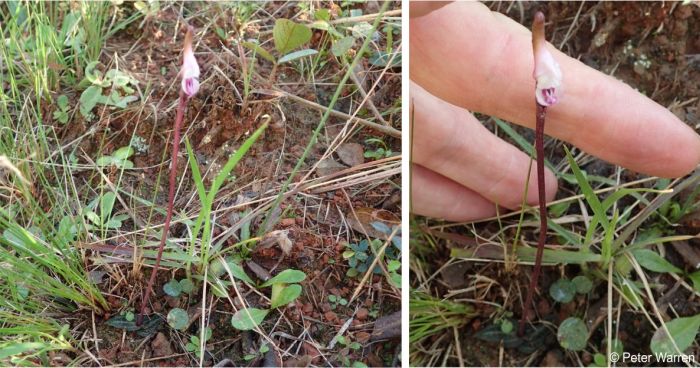
Derivation of name and historical aspects
History
This species is named after John Medley Wood, a farmer, trader, botanist and plant collector in KwaZulu-Natal, Curator of the Durban Botanic Gardens from 1882 and the founder of the Natal Herbarium. The genus name Disperis refers to the pouches formed by the lateral sepals and its derivation is from the Latin words dis meaning ‘double’ and pera meaning ‘pouch’, ‘wallet’ or ‘sac’. The Afrikaans name moederkappie, meaning ‘mother’s bonnet’ was given to plants in this genus because the hooded flowers resemble the old-fashioned bonnets that women used to wear.
Disperis is a genus of plants belonging to the orchid family, comprising approximately 78 different species. This genus includes two subgenera: Disperis and Dryorkis. The subgenus Disperis consists of approximately 30 species that are characterized by the presence of a complete attachment of the lip. The majority of its species originate from southern Africa, with only a few from East Africa and Madagascar. The subgenus Dryorkis consists of approximately 48 species and is distinguished by its lip attachment, which has two lobes. Most of the species are from tropical and southern Africa, as well as Indian Ocean islands with one species, Disperis neilgherrensis, that is widely distributed in tropical Asia.
Ecology
Ecology
Disperis woodii is pollinated by oil collecting bees of the Rediviva genus.
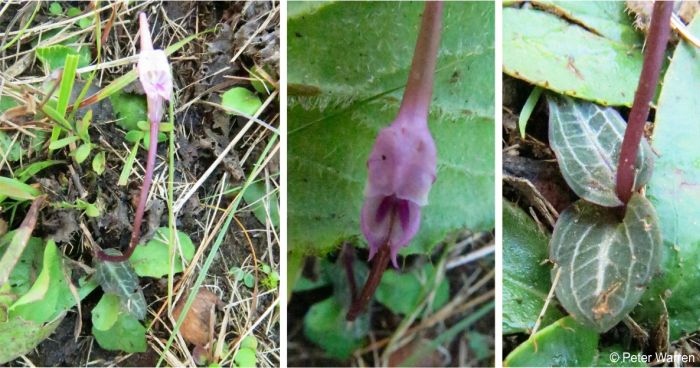
Uses
Use
Disperis woodii is not generally grown as an ornamental plant but may be of interest to orchid collectors. It can be grown in warm, humid gardens with well-drained sandy soil, or in a controlled environment. There is no recorded information about traditional uses of Disperis.
Growing Disperis woodii
Grow
Disperis woodii is not known in cultivation and is quite difficult to grow. It can be propagated by seeds. For successful germination sow the seeds in a soil mix that drains well and keep them warm and moist. Grow this plant in a well-drained soil mix that is enriched with well-rotted compost, in a small pot or a shallow container. Place in a warm, humid, well-lit area with some shade and protect from strong winds.
Disperis woodii needs moisture in spring, summer and autumn but can tolerate a dry winter. It is recommended to water once a week during the summer growing season. In autumn and winter, it is advisable to reduce the frequency to once every 10 days or withold watering until spring. To maintain moisture in the air, it is recommended to spray a fine mist, especially during dry weather. Orchids prefer water that has a neutral pH.
Disperis woodii does not need much fertilizer. In order promote growth, apply some nitrogen-rich fertilizer in spring and balanced fertilizer in summer.
References
- Bowers-Winter, G. 2022. Observation of Disperis woodii, Ray Nkonyeni Rural, KwaZulu-Natal. iNaturalist. Online. https://www.inaturalist.org/observations/129390765.
- Dargle Conservancy online. Disperis woodii Bolus – Wildflower Index. https://www.dargleconservancy.org.za/wildflowerarchive/wfa062016.php. Accessed 08/10/2023.
- Fourie, C. 2023. Observation of Disperis woodii, Mbumbulu Rural, KwaZulu-Natal. iNaturalist. Online. https://www.inaturalist.org/observations/156869824.
- Johnson, S. & Bytebier, B. 2015. Orchids of South Africa: a field guide. Penguin Random House, South Africa.
- Johnson, S.D., Bytebier, B. & Stärker, H. 2010. Orchids of South Africa: A field guide. Struik Nature, Cape Town, South Africa.
- Kurzweil, H. & Manning, J.C. 2005. A synopsis of the genus Disperis Sw. Orchidaceae. Adansonia 27:155–207.
- Linder, H.P. & Kurzweil, H. 1999. Orchids of Southern Africa. A.A. Balkema, Rotterdam.
- Manning, J.C. & Linder, H.P. 1992. Pollinators and evolution in Disperis (Orchidaceae), or why are there so many species? South African Journal of Science 88:38-49.
- Pailler, T. Tamon, M.-J., Henze, F. & Bytebier, B. 2019. A new Disperis (Orchidoideae; Orchidaceae) for the flora of the Mascarenes. Phytotaxa 423(5):293-296.
- Pooley, E. 1998. A field guide to wild flowers Kwazulu-Natal and the eastern region. Natal Flora Publications Trust, Durban.
- Selina Wamucii online. Disperis woodii -Uses, Benefit and Care. https://www.selinawamucii.com/plants/orchidaceae/disperis-woodii/. Accessed 30/10/2023.
- Smith, C.A. 1966. Common names of South African plants. Memoirs of the Botanical Survey of South Africa No. 35. Government Printer, Pretoria.
- Von Staden, L. 2018. Disperis woodii Bolus. National Assessment: Red List of South African Plants version 2020.1. Accessed on 2023/10/08
- Warren, P. 2014. Observation of Disperis woodii, Msunduzi District, KwaZulu-Natal. iNaturalist. Online. https://www.inaturalist.org/observations/10959644.
- Warren, P. 2016. Observation of Disperis woodii, Shongweni, KwaZulu-Natal. iNaturalist. Online. https://www.inaturalist.org/observations/11237359.
Credits
Monde Zulu
KwaZulu-Natal National Botanical Garden
December 2023
Acknowledgements: the author thanks his colleague Mr. Bhekisisa Patrick Gcumisa for providing relevant information for this article, and Gail Bowers-Winters, Carel Fourie and Peter Warren for making their images available via iNaturalist.
Plant Attributes:
Plant Type: Orchid
SA Distribution: Eastern Cape, KwaZulu-Natal
Soil type: Sandy
Flowering season: Late Summer, Autumn, Winter
PH:
Flower colour: White, Pink
Aspect: Morning Sun (Semi Shade), Afternoon Sun (Semi Shade)
Gardening skill: Challenging
Special Features:
Horticultural zones







Rate this article
Article well written and informative
Rate this plant
Is this an interesting plant?
Login to add your Comment
Back to topNot registered yet? Click here to register.